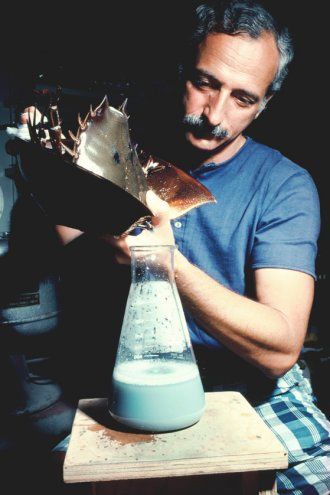How a Study of Horseshoe Crabs Led to Safer Joint Replacements
UCSF Researcher Honored for Work That Created Test for Bacterial Contamination
At first, it just didn’t make sense. It was 1963, and a young research fellow at Johns Hopkins medical school was spending the summer on Cape Cod, studying blood coagulation in an animal totally unfamiliar to him – the horseshoe crab, Limulus polyphemus, a catcher’s mitt-shaped creature with an evolutionary history stretching back nearly half a billion years.

Jack Levin, MD, carrying out his early studies with horseshoe crabs in the late 1960s. Photo courtesy of Jack Levin
That young scientist, Jack Levin, MD, was trying to find out if the cells normally circulating in the horseshoe crab’s blood, called amebocytes, triggered clotting, as platelets do in human blood.
It was an interesting substance to study. In horseshoe crabs, oxygen is not carried within iron-rich red blood cells as it is in mammals. Instead, an oxygen-transporting protein in the blood called hemocyanin does the task. Hemocyanin contains copper, and this turns oxygenated blood blue.
But after his first few weeks at the Marine Biological Laboratory in Woods Hole, Mass., Levin was baffled. Blood samples that were liquid when he left his lab at night were solidly clotted when he returned the next morning. He tried preventing the clotting with standard blood anticoagulants – to no effect.
Although he couldn’t have imagined it at the time, that stubbornly clotted crab blood, such an annoyance on those summer mornings at the bench, was a blessing in disguise: It would prove key to devising a test that, nearly 60 years later, would see Levin, now a UC San Francisco professor emeritus of Laboratory Medicine, honored at the Library of Congress for work that the Johns Hopkins Bloomberg School of Public Health has placed among the “100 Most Important Contributions to Public Health.”
Endotoxins and a Eureka Moment
Levin’s previous research at Hopkins had shown that endotoxins – a component of the bacteria that cause pneumonia, meningitis and other diseases – triggered blood clotting in rabbits. Research by others had shown that these toxins also caused clotting in patients with sepsis. So Levin wondered if maybe his blood samples were somehow contaminated with bacterial endotoxin.

Amebocytes are mobile cells found in the blood of many invertebrates like horseshoe crabs. Image courtesy of Jack Levin
Sure enough, when he changed his methods and drew the crab’s blood into tubes he was sure were free of endotoxin, the blood didn’t clot.
“It was a eureka moment,” he says. “I hadn’t really come to Woods Hole to study endotoxins, but I knew they clotted rabbit blood, so I guessed that endotoxin might affect blood in horseshoe crabs the same way. It was serendipity.”
This did not turn out to be a one-off finding in an obscure animal. The following year, Levin showed that granules inside amebocytes, mobile cells found in the blood of many invertebrates like horseshoe crabs (somewhat like white blood cells in vertebrates), somehow trigger coagulation in the presence of endotoxin. And, going deeper, he soon determined that enzymes within the granules were the true agents responsible for the clotting.
Then, he and colleagues recognized that this series of discoveries might form the basis for a new way to detect bacterial contamination.
Developing a Sensitive Test for Bacterial Infection
Levin and his colleagues developed a test they called the Limulus amebocyte lysate, or LAL, test to identify the presence of endotoxins using extracts of amebocytes obtained from horseshoe crab blood.
Approved by the FDA for use in 1977, the LAL test can detect bacterial endotoxin at levels less than one part per trillion, and it has become the world standard for sensitive and relatively inexpensive detection of endotoxin in everything from chemotherapy infusions to the material used in knee or hip replacements.

Jack Levin, MD
In the presence of endotoxin, enzymes in the horseshoe crab’s amebocytes trigger formation of a gel-like coagulation, rather than a solid clot. Importantly, the rate of production of this gel correlates with the concentration of endotoxin, so the LAL test provided the first biological test for bacterial endotoxins that can directly measure their concentration.
The LAL test is now used to ensure safety in about 200,000 cardiac pacemakers in the U.S. every year. It has allowed doctors to implant nearly 5 million knee replacements and about 2.5 million artificial hips without fear of bacterial contamination.
Drugs are regularly tested for contamination with this method too, allowing the pharmaceutical industry to track endotoxin concentration during drug production and to determine if contamination has occurred during the process, or if endotoxins have been reduced or eliminated, and it is also used to assure safety in blood transfusions and water supplies.
Stressing Importance of Basic Research
In September 2019, the American Association for the Advancement of Science (AAAS) honored Levin for this groundbreaking discovery and the development of the life-saving LAL test with its Golden Goose Award. The award’s name is a counterpoint to the infamous Golden Fleece Award championed in the 1970s and ’80s by the late Sen. William Proxmire, who lampooned research that he saw as esoteric and a waste of taxpayer dollars. In the words of AAAS, the Golden Goose Award celebrates “silly-sounding research that has returned serious benefits to society.”
Watch a video from the Golden Goose Award about Jack Levin’s work.
After his seminal summer work at the Marine Biological Laboratory, Levin became a professor of medicine at Johns Hopkins School of Medicine, and in 1982, he was recruited by UCSF to establish a research laboratory to study the biological effects of endotoxins and regulation of blood platelet production.
Levin continuously stresses a point captured by the intent of the Golden Goose award: that basic research combined with the ability to recognize the potential of unanticipated results is highly valuable to society. Serendipity, he has said, “is an unexpected observation combined with a mind that is prepared to consider and interpret the observation.”
